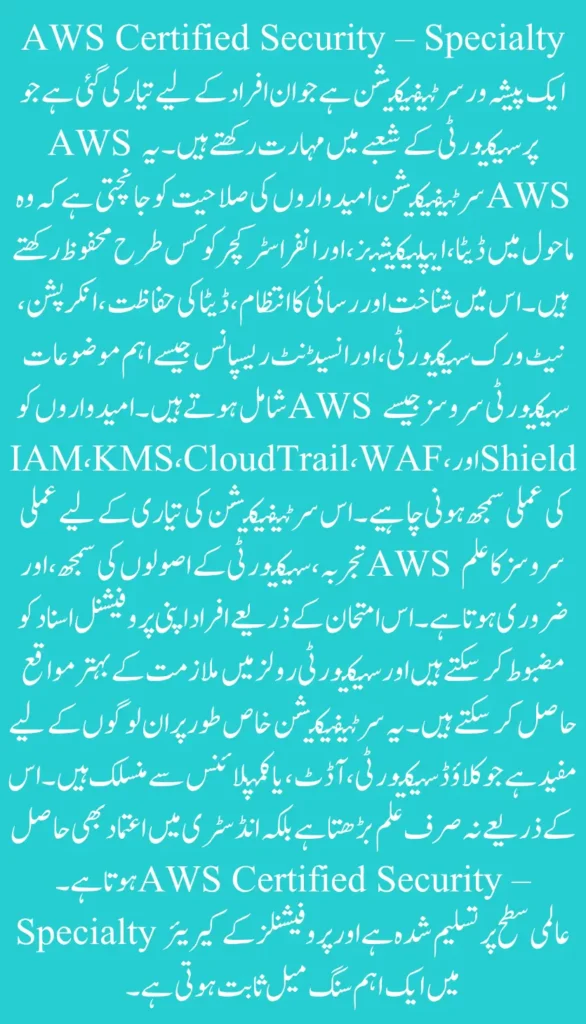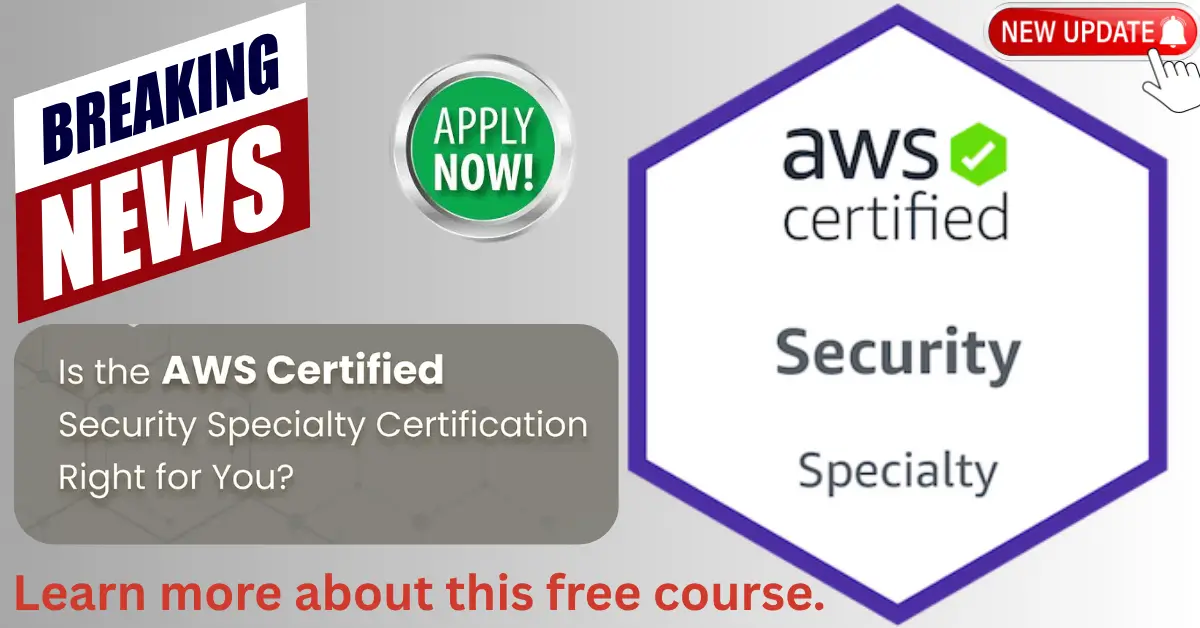AWS Certified Security
This course provides an in-depth and comprehensive study of security practices in the AWS cloud environment. You will learn how to protect applications, data, and network infrastructure while preparing for the AWS Certified Security – Specialty exam through practical labs, real-world scenarios, and in-depth coverage of essential security concepts. AWS Certified Security.

Course Overview: AWS Certified Security
- Gain a solid foundation in cloud security principles and risk management practices.
- Master identity and access management using AWS IAM for secure resource control.
- Design effective strategies to safeguard applications and data within AWS.
- Implement AWS encryption tools to protect and manage sensitive information.
What You’ll Learn: AWS Certified Security
- Grasp core concepts of cloud security and risk management.
- Manage user identities and access with AWS IAM.
- Design strategies to secure applications and data on AWS.
- Leverage AWS encryption services to protect sensitive information.
- Understand the AWS Shared Responsibility Model and its security roles.
- Configure secure network environments using VPC, security groups, and NACLs.
- Set up logging and monitoring with AWS CloudWatch and CloudTrail.
- Detect and mitigate security risks across AWS services.
- Utilize AWS Key Management Service (KMS) for effective encryption management.
- Apply security updates and patches in AWS environments.
- Secure data at rest and in transit using built-in AWS tools.
- Establish and manage incident response protocols in the cloud.
- Employ vulnerability management practices to protect AWS workloads.
- Use AWS Shield, WAF, and other services to defend applications.
- Prepare thoroughly for the AWS Certified Security – Specialty exam with practice tests.
- Enable multi-factor authentication (MFA) and other advanced security features.
- Build and maintain a strong cloud security posture.
- Secure containerized applications within AWS infrastructure.
- Create a secure CI/CD pipeline using AWS-native security tools.
Punjab Approves CM Honhaar Scholarship for All Other Provinces
Requirements for AWS Certified Security
- Basic knowledge of AWS services and architecture
- Familiarity with security concepts and cloud technologies
- A computer with internet access for hands-on labs and exercises
Introduction to AWS Security
- Learn the foundational principles of cloud security in AWS environments.
- Understand key AWS-specific security concepts and best practices.
- Dive into the AWS Shared Responsibility Model and its security implications.
- Get familiar with the range of AWS security services and tools.
- Identify common security challenges in cloud-based infrastructures.
- Explore the basics of cloud risk management and threat assessment.
- Develop and maintain a strong security posture within AWS.
- Learn about data privacy standards across various AWS regions.
- Recognize cloud-specific security risks and how to effectively mitigate them.
- Implement robust security controls using AWS-native solutions.
- Utilize AWS tools for threat detection, monitoring, and incident response.
- Configure and manage logging and monitoring across AWS infrastructure.
Identity and Access Management Security
- Understand the purpose and functionality of AWS IAM in managing access.
- Learn how to manage users, groups, and permissions within AWS.
- Create and configure IAM policies for fine-grained permission control.
- Enable multi-factor authentication (MFA) to enhance account security.
- Secure AWS services by assigning appropriate IAM roles and permissions.
- Protect sensitive data and credentials through proper IAM configurations.
- Follow best practices to strengthen the security of IAM resources.
- Audit and monitor IAM usage to ensure policy compliance.
- Enforce least privilege access to minimize security risks.
- Use AWS Organizations to manage identities and policies across multiple accounts.
- Integrate IAM with AWS Security Hub for centralized compliance and monitoring.
- Leverage IAM roles to securely manage access for applications and infrastructure.
NADRA Launches New Version of ‘Pak ID’ Mobile App – Check Out the Latest Features!
Data Protection and Encryption
- Explore AWS encryption options and their appropriate use cases.
- Learn how to use built-in AWS services to encrypt data at rest securely.
- Learn best practices for encrypting data in transit across AWS environments.
- Utilize AWS Key Management Service (KMS) to manage encryption keys and ensure secure data encryption.
- Use AWS CloudHSM to enable hardware-based encryption for sensitive workloads.
- Understand and apply envelope encryption techniques for layered data protection.
- Encrypt data stored in Amazon S3 and Amazon RDS for enhanced security.
- Utilize AWS Certificate Manager (ACM) to manage and deploy SSL/TLS certificates.
- Apply encryption controls to secure data in transit using AWS networking features.
- Manage data key rotation securely with AWS KMS.
- Leverage Amazon Macie to automatically identify and safeguard sensitive data across your AWS environment.
- Understand the importance of encryption in meeting compliance and audit requirements.
- Enforce encryption standards and policies with AWS Config.
- Configure secure storage volumes using encrypted Amazon EBS.
- Set up fine-grained data access controls to protect encrypted resources.
Network Security in AWS
- Gain a solid understanding of core AWS network security principles.
- Use security groups to control inbound and outbound traffic at the instance level.
- Configure network ACLs (Access Control Lists) for enhanced subnet-level security.
- Leverage Amazon VPC to create isolated and secure network environments for your applications.
- Secure communication between VPCs using VPC Peering.
- Set up secure Virtual Private Network (VPN) connections for hybrid environments.
- Utilize AWS Direct Connect for private, high-bandwidth, and secure connectivity.
- Deploy AWS Transit Gateway to securely manage communication across multiple VPCs.
- Protect web applications with AWS Web Application Firewall (WAF) rules and filters.
- Use AWS Shield to safeguard against DDoS attacks and enhance application resilience.
- Isolate critical resources using VPC subnets, route tables, and security rules.
- Ensure secure inter-instance communication through proper network configurations.
- Implement Network Traffic Mirroring for advanced threat detection and monitoring.
- Detect anomalies and threats within your VPC using Amazon GuardDuty.
- Set up and manage private connectivity solutions for secure and reliable data transfer.
Incident Response and Security Operations
- Create and implement an effective incident response plan tailored for AWS environments.
- Detect, investigate, and respond to security events using AWS-native tools.
- Monitor API calls and user activity with AWS CloudTrail for enhanced visibility.
- Enforce and track compliance using AWS Config Rules for security configuration management.
- Centralize threat detection and security alerts with AWS Security Hub.
- Utilize Amazon CloudWatch for real-time monitoring, metrics, and automated alerts.
- Automate security responses and remediation using AWS Lambda functions.
- Conduct root cause analysis to understand and resolve security incidents efficiently.
- Analyze vulnerabilities and assess risks with Amazon Inspector.
- Integrate CloudWatch Logs with third-party SIEM platforms for extended threat analysis.
Empowering Youth: Pakistan Launches NVTTI | AWS Certified Cloud Practitioner
